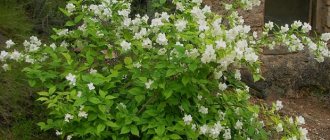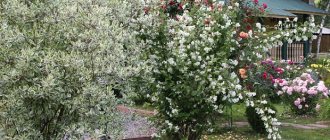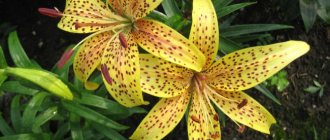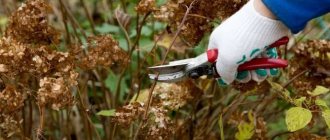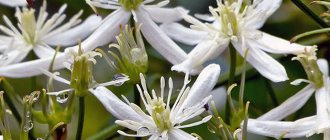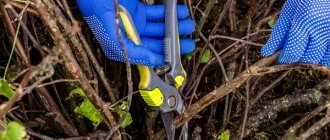Quote from Yuri_Dudanov
Read in full In your quotation book or community!
/sadovodu.com/wp-content/uploads/2017/09/bszhasmina_osen_1-300×225.jpg" target="_blank">https://sadovodu.com/wp-content/uploads/2017/09/bszhasmina_osen_1-300 ×225.jpg 300w» />
Preparing for winter and proper autumn care are responsible measures that allow jasmine to easily endure frosts and winters with little snow.
Features of care and preparation for winter
Jasmine is a perennial shrub, but in order for it to always delight with its beauty and delicate aroma, it needs nutritious soil. Lush flowering can only be achieved if it is saturated with minerals and nutrients. The plant also needs regular, abundant watering, and, of course, pruning. There are three types of it:
- Sanitary.
- Rejuvenating.
- Formative.
In the spring, formative pruning is carried out, thickening branches and shoots frozen in winter are removed. Rejuvenation is carried out once every 5-8 years, since the old branches will no longer produce such lush flowering. Sanitation is carried out in the fall.
You may be interested in:
Pruning an apple tree: when and how to do it correctly Apple trees are among those fruit trees that love abundant natural light and do not tolerate stagnant air...Read more...
Plot
7 votes
+
Vote for!
—
Vote against!
The aroma of jasmine is well known from childhood. A wonderful miracle in the parent's garden! A huge spreading bush with star-shaped snow-white and cream flowers attracts with its exotic and sweet smell. No other shrub has such a fragrant and pronounced aroma. The article will tell you how to grow jasmine in your garden.
In Latin, mock orange sounds like Philadelphus. The plant is named after Cleopatra's son, Ptolemy Philadelphus. All his life he loved fragrant flowers and incense. And people call it mock orange. In the distant past, a smoking pipe was made from twig-like straight shoots, part of which is called “chubuk”. The wood of the bush is hard, so it is used to make flutes, pipes and other crafts.
Jasmine planting and care
To grow a beautiful and neat plant, you should know and follow certain agricultural techniques.
- The plant tolerates shade, so it can grow both in shaded areas and in the sun. Planted jasmine in a well-lit place will bloom more abundantly and develop quickly.
- Planting jasmine seedlings can be done in autumn or early spring. These periods are favorable for the rooting and development of young plants.
Soil for planting garden jasmine
- Jasmine is not picky about the soil, but it can only reveal itself in all its glory on fertile soil. The shrub does not tolerate stagnant water, so it must be planted in a high area or by making preliminary drainage from crushed stone with sand, broken brick or gravel. The layer height must be at least 15 cm.
- For a seedling, you need to dig a hole 50 cm deep, fill it with fertile soil and add 30 g of nitrophoska. When planting, you need to ensure that the root system is not buried more than 3 cm into the soil. The soil around the seedling is compacted and watered abundantly.
Feeding jasmine bushes
- Feeding mock orange bushes begins a year after planting.
- Mineral fertilizers . For 10 liters of water you will need: superphosphate – 30 g; urea – 15 g; potassium sulphide - 15 g. All ingredients are stirred in a bucket of water and the contents are poured under 1-2 jasmine bushes. Faded shrubs should be fed by adding 15 g of potassium and 20 g of superphosphate to the soil.
- Organic fertilizers . Slurry has proven itself well. To prevent the plant from getting burned, organic fertilizer is diluted with water in a ratio of 1:10. It is recommended to carry out this feeding once a year. You can use birch or apple ash, embedding it in the soil under the jasmine. For one bush, it is enough to take 100 g of fertilizer.
Formation of a jasmine bush and anti-aging pruning
Often, tall varieties of garden jasmine acquire an asymmetrical shape, which is associated with different growth rates of the plant. To make it more neat, regular formative pruning will be required.
- You can give jasmine a beautiful look during the growing season. At the beginning of spring, when it becomes warm, it is necessary to trim long branches a little, and shorten weak ones by half. This procedure will enhance the active growth of young shoots.
- Over time, the bush grows, the branches become bare and choke the plant. Without a doubt, such a look does not decorate jasmine. Anti-aging pruning is required .
- With the arrival of spring, 4-5 trunks are shortened to half a meter, and all other shoots are cut to the ground. To prevent the development of fungal diseases, bare areas need to be treated. Garden varnish is a good remedy for plant protection. Mulch the surface substrate with compost and pour mullein infusion onto the soil. During the growing season, jasmine loves regular watering, 20-30 liters per adult plant.
- Young shoots grow from dormant buds. They are removed almost completely. It is recommended to leave only the 2-3 strongest branches on each stump. They will be the basis of the new bush. Within a year, jasmine takes on a decent appearance, and after 3 years you can enjoy flowering.
- Sanitary and cosmetic pruning is carried out every year. You should thin out the bush, remove excess shoots, and promptly remove flowers that have lost their attractive appearance.
Preparing jasmine for winter
- An adult jasmine bush does not need any additional preparation; it tolerates cold temperatures well. During the winter, the tops of young branches may become damaged, but in the spring, after formative pruning, jasmine quickly gains strength and is restored.
- But it is not so easy for young seedlings to withstand the winter cold, therefore, if the bush is not even a year old, it should be covered with light material and secured with rope in late autumn.
Jasmine planting and care photo
- In late autumn, the soil is dug up and covered with mulch near the plant trunk, as well as garden compost, manure or pine needles. This will prevent the root system from freezing.
- The garden shrub, thanks to its unpretentiousness in care and ease of propagation, has won the hearts of gardeners. An adult, beautifully flowering mock orange is the hallmark of the garden! Enchanting aroma, abundant flowering, snow-white and creamy, simple and beautiful, fluffy double flowers attract the eye of every passerby. You just want to stop, breathe in the unique aroma and enjoy the beauty of garden jasmine.
Methods for propagating jasmine
There are many ways to obtain a new specimen of your favorite variety. Garden jasmine is propagated by layering, woody and green cuttings, as well as seeds. The last method is time-consuming, quite labor-intensive and takes a lot of effort. Jasmine blooms only in 7-8 years.
Seed propagation
- Small, dusty mock orange seeds are planted in pre-prepared beds even before the onset of severe frosts. Sowing is carried out in December, when the snow cover rises above the site and reaches 15 cm in height.
- The seeds are planted in the soil and the beds are covered with spruce branches. During the winter they undergo natural stratification. In the spring, with the first rays of the sun, the snow cover will begin to melt and be absorbed into the ground, saturating the seeds with moisture. After some time, the first green shoots will appear.
- The quality of seedlings grown from seeds is quite high. They are less susceptible to diseases and tolerate harsh winters well.
Reproduction by layering
- With the onset of spring warmth, all shoots must be cut off from the mother bush. Over the summer, young shoots grow near the plant. The strongest and strongest can be used for reproduction.
- At the very bottom of the shoot, under the first developed bud, it is recommended to tie the lignified branch with copper or aluminum wire. This procedure will entail the formation of a root system. All that remains is to tilt the shoots towards the ground into pre-prepared shallow grooves. The shoot is placed in a hole and secured with wire in several places for good fixation. The grooves must be filled first with sand and then with peat.
- After just 1.5 months, new shoots will grow on the cuttings, which need to be covered with soil twice during the growing season. In the fall, they are shortened, separated from the mother bush and transplanted to a new place for growing.
Propagation by young cuttings
- June is the most suitable month for harvesting planting material. Which cuttings are suitable for propagation? If you take a shoot 10 cm long and bend it into a ring, it should not break.
- You need to start preparing the material in the morning; at this time the branches contain enough moisture. Under the lower bud they cut obliquely, and above the upper bud – in a straight line. The leaves are shortened by half; you should not tear them off completely.
- A greenhouse is the most convenient place for rooting young parts of shrubs. The substrate for plant development should consist of sand and weathered peat, taken in equal quantities. Before planting, it is recommended to keep the cuttings in a solution that promotes root formation for 20 hours. The planting depth is 3 cm. There should be a distance of 5 cm between the cuttings. The lower leaves should not be buried in the ground.
- For 2 weeks, to maintain moisture, it is advisable to spray the cuttings, shade them from sunlight and ventilate the greenhouse. You won’t have to wait long; after a while, whitish dots will appear, and then roots. At this time, it is necessary to gradually accustom the seedlings to the air. Young plants are grown in the garden bed.
- If it is not possible to propagate in a greenhouse, this can be done directly in the garden bed or garden. The cuttings are planted at an angle and covered with a cut plastic bottle. For the first 2 days, you cannot open the miniature greenhouse, and then daily ventilation is necessary so that the young seedlings do not burn out.
Propagation by shoots with dense wood
- In the fall, when the bush is free of foliage, shoots 15 cm long are harvested. They cut directly under the lower bud, and obliquely above the upper bud. The prepared branches are placed in a box, covered with sand and sent to a cool place for winter storage.
Important! In the spring, they begin planting overwintered cuttings in the garden bed. You can't waste time, the kidneys shouldn't swell!
- By autumn, the root system will appear and young shoots will develop.
Reproduction by dividing the root system
- This method is used only when you want to get another jasmine bush in a short time. To do this, you need to dig up the jasmine and divide the root system so that each plot has basal shoots. It is more convenient to divide the bush into parts using garden shears. Reproduction cannot be carried out during flowering; the best period is October.
What does jasmine suffer from and what pests can it damage?
Mock orange is a strong shrub; pests do not like jasmine. But it would be a good idea to inspect garden jasmine for insects from time to time. You can fight pests with folk remedies, of which a solution of laundry soap is the most effective.
Jasmine can be attacked by:
- weevil;
- aphid;
- spider mite;
- mealybug;
- soft false shield.
If folk remedies do not help, you can treat with insecticides.
Tips for caring for garden jasmine
- Weekly loosening of the soil;
- weed removal;
- use of organic fertilizers;
- mineral fertilizers;
- forming a bush, pinching the top to give the correct shape;
- timely watering, preventing the soil from drying out;
- removing faded inflorescences;
- thinning the bush as necessary, removing weak and old shoots.
- application of phosphate-containing fertilizers to enhance flowering.
Working on creating a landscape composition
- You can make a hedge from garden jasmine by planting shrubs along the perimeter of the site, at a distance of up to 1 m. The shrub grows well and if planted close to each other, you will get a thickened “wall” that will be difficult to cope with.
- In early June, the common mock orange . the small-leaved variety pleases with its fragrant flowers and passes the baton to a shrub with a translucent crown - Schrenk's mock orange . At the end of June, the odorless mock orange blooms. The name itself speaks for itself: the flowers of this variety are odorless, therefore they are recommended for people prone to allergies. Mock orange Lemoine is one of the most beautiful shrubs, finishing its flowering.
- Having collected a collection of various varieties on the site, which differ in their painted foliage and timing of bud blooming, you can contemplate their beauty for 2 months. Low-growing varieties are suitable for decorating a rock garden or rock garden; tall varieties can be planted in the center to create a background.
On a note! There are varieties of jasmine that are covered with flowers 2 times during the season. And from the low jasmine, which is used to decorate rock gardens, you may not even get flowers. Therefore, it is recommended that allergy sufferers keep low-growing species on their property.
- Garden jasmine with simple flowers looks beautiful next to lilac, but mock orange with fringed flowers is better planted separately from other plants. A single planting will make it stand out among other varieties.
Why prune jasmine
The procedure is carried out in order to preserve the beautiful appearance of the bushes, because sometimes the shoots grow inward and thicken the plant; many people like to give the bushes different shapes. And sometimes jasmine is used by landscape designers in compositions, and this beauty needs to be maintained. Old branches no longer produce such lush flowering, but at the same time the plant spends a lot of energy on their growth and development. In addition, they draw a large amount of nutrients from the soil. If you do not care for the plant, it will look damaged.
Pests and diseases and their treatment
Garden jasmine is very rarely affected by harmful insects. Of all the pests of garden plants, aphids and red spider mites can live and reproduce on it.
Aphids attack young shoots of jasmine and often breed on them in large numbers. It feeds on plant sap, which causes the youngest leaves to curl and dry out. If appropriate measures are not taken, the bush will stop growing and will not bloom.
Spider mites are very small harmful representatives of arachnids. Feeding on the sap of the plant, it settles on the underside of the leaves. It is not easy to detect, but its presence is revealed by cobwebs on the tops of shoots and the underside of leaf blades.
To completely destroy pests, it is necessary to treat the plant with insecticidal preparations. They are used twice, with a break between treatments of 7-10 days.
Garden jasmine is very resistant to various diseases. Only sometimes it is affected by root rot. But this only happens due to errors in caring for the plant and the wrong choice of planting site.
Root rot occurs when there is excess moisture in the soil . This can happen due to overwatering or when planting the bush in a wetland. In the first case, the bush should be watered less, and in the second, it should be urgently transplanted to a new location.
When is the best time to prune mock orange?
Jasmine is unpretentious, it tolerates pruning well and quickly recovers after it. The procedure can be carried out throughout the season; frozen shoots are cut off in the spring and thickened in the summer. After the end of the flowering period, unfallen buds are removed. As for sanitary and anti-aging pruning, it is most often carried out in the fall. Remove excess shoots, as well as those that will no longer bloom so luxuriantly. It is believed that autumn pruning will help prepare jasmine for cold weather. Also in the fall, before or after pruning, fertilizers are applied; they will help restore the bush’s strength after flowering.
On a note!
If fertilizing is applied after pruning, then this should be done 14 days after the procedure.
Technology for propagating jasmine by cuttings in autumn
Jasmine bushes can be propagated in several simple ways, but cuttings are the most preferable option for obtaining a beautiful flowering plant:
- in late autumn, after the leaves have fallen, lignified shoots are cut off, from which cuttings are prepared;
- the cut cuttings are placed in boxes filled with fairly well-moistened sand, where the planting material is stored throughout the winter at a temperature of 0-3°C, preferably in a basement or cellar;
- in early spring, harvested cuttings are soaked for about a day in a solution based on the Epin-Extra biostimulator at the rate of 1 ml per liter of warm and settled water;
- planting should be carried out in a moist nutrient soil mixture based on turf soil and sand in a 1:1 ratio;
- plantings are covered with polyethylene, which will achieve a greenhouse effect.
Basic rules for autumn pruning
For the first time, jasmine is pruned immediately after planting; experienced gardeners recommend leaving only 3-4 of the strongest trunks. You should not feel sorry for the young shoots; in a year they will grow twice as powerful, and jasmine will decorate your garden plot with its appearance.
For the pruning procedure, you need to prepare sharpened, sterile garden tools. Young growth and thin branches can be trimmed using secateurs or loppers. But they are not suitable for removing old and powerful branches; a hacksaw is used for them. First, using pruning shears, remove the inflorescences that have not fallen off, then the branches that are dry or have damage and signs of disease. After thickening the shoots. And in the end, you can give the bush the desired shape. The procedure is carried out very carefully; when cutting down old branches, you cannot damage the young shoots, because it is they that will produce abundant flowering next year. The cut areas are treated with garden pitch or other antiseptic; this will protect the bush from infections and pathogenic microorganisms.
You may be interested in:
How to prune and cover a climbing rose correctly for the winter Winter is a severe test for the fragrant beauty of a rose. In our latitudes there are often temperature changes, and...Read more...
Inexperienced gardeners first need to learn how to trim jasmine evenly, and after a few years they can give the bush any shape. Also, cuttings are often prepared in the fall and planted the following season. To do this, young shoots are cut off along with a piece of the trunk and cut into cuttings. Their length should be approximately 5 cm, and one cutting should also have a pair of internodes and a small amount of foliage. The cut under the internodes should be at an angle of 90 degrees, above the bud it is cut horizontally. Planting material is stored until spring in a dry room at a temperature of 0 0 Celsius.
Reproduction methods
After a few years, when the bushes are already sufficiently formed, it is time to think about propagating jasmine. There are several methods, and it is necessary to consider each of them separately.
Did you know? There are about 200 types of jasmine. Most of them have a similar appearance and a characteristic bright aroma, but there is one type of culture that stands out among all. This is Japanese jasmine. Its peculiarity is that it has practically no odor, and the petals take on a narrow and pointed shape.
Cuttings
Cuttings are one of the most popular methods, since the percentage of germination after such propagation is quite high . It is recommended to take cuttings in early June. After cutting, the cutting must be planted either immediately in open ground, or additionally allowed to grow stronger in a greenhouse (depending on the region, for example, in the Moscow region and adjacent regions, you can immediately plant it in the garden).
By layering
Reproduction by layering (shoots) is usually carried out in the fall : several of the strongest shoots are separated from the main (mother) bush and placed in a specially prepared hole or container. The shoots are left for the winter, and in early spring they are completely ready for further transplantation to a permanent place in the open ground.
By division
Root division is rarely used to plant jasmine. For this method, you need to dig up a mature bush and carefully divide the rhizome into several parts with a shovel, after which each daughter bush is planted in prepared holes . Planting material planted in autumn, as a rule, takes root faster and better.
Seeds
Propagation by seeds is a fairly popular, however, labor-intensive method. Seeds can be germinated at home and planted on a windowsill as seedlings (the percentage of seedlings will be higher), or immediately placed in open ground at the end of spring.
Caring for a bush before and after pruning
After the procedure, any plant needs careful care. Despite the fact that jasmine tolerates pruning well, it is no exception. Firstly, you need to control the soil moisture, it should not dry out. If it is warm outside, water the jasmine once a week. During periods of drought and high air temperatures, watering is carried out twice a week. In addition to the use of mineral fertilizers, mullein or rotted manure is added to the soil two or three times during the summer. This will provide the bush with nutrients, and in the future will increase the quantity and quality of buds.
In the fall, if it rains often, they stop watering altogether, but if the weather is dry, then the last time before winter I water it 14 days before the first frost. Watering will require from 10 to 20 liters of water, the amount depends on the age of the plant. Also, before winter, mineral supplements are applied; the most necessary substances for mock orange during this period are potassium and phosphorus.
On a note!
Fertilizers are applied before it gets completely cold, otherwise the plant will not have time to absorb them.
After pruning, all fallen leaves and cut branches are removed near the jasmine, because pathogens and parasites can overwinter in them. After harvesting, the bush is sprayed with copper-containing preparations for preventive purposes.
Features of propagation of jasmine by cuttings (video)
Fermented slurry, which is diluted in a ratio of 1:10, is excellent for feeding. About a couple of years after planting, it is very important to use mineral fertilizers to feed the flowering crop.
The first feeding of garden mock orange is carried out, as a rule, in the spring, around mid-May. For this purpose, a nutrient solution is introduced under the plants, based on a mixture of 30 g of superphosphate, 15 g of urea and 15 g of potassium sulfate, diluted in a bucket of warm and clean water. When preparing mock orange for the winter, special attention should be paid to proper feeding of the ornamental shrub. Only with proper application can you count on easy overwintering of the crop. After flowering, each square meter of planting area requires fertilizing, the composition of which is 25 g of superphosphate, 100 g of wood ash and 15 g of potassium sulfate.
/sadovodu.com/wp-content/uploads/2017/09/bszhasmina_osen_123-300×225.jpg" target="_blank">https://sadovodu.com/wp-content/uploads/2017/09/bszhasmina_osen_123-300 ×225.jpg 300w» />
When preparing mock orange for the winter, special attention should be paid to proper feeding of the ornamental shrub.
Organizing shelter for the winter
Jasmine is classified as a frost-resistant plant; there are varieties that can withstand even severe frosts. In the southern regions of the country, the crop does not need shelter; in the middle zone, individual varieties are covered. Young shrubs are more susceptible to freezing, so in the first years it is better to cover them.
The soil in the tree trunk circle is first dug up, then mulched with a thick layer (20 cm) of rotted manure or peat. Mulch protects the roots from freezing, as they are more susceptible to cold weather. The top of the plant can be covered with any covering material.
What difficulties are encountered when growing indoor jasmine?
Indoor jasmine, which has its own characteristics when caring for it at home, is sometimes capricious. I made a table for you to make it easier for you to figure out what's what and how to fix it.
| What's happened | Cause | How to fix |
| Elongated stems, small leaves, the plant does not bloom. | Lack of light. | Move it closer to the light or illuminate it with a powerful lamp. In the spring, trim off all bald branches and provide maximum light in the summer. |
| Growth in winter, leaves become smaller, no flowering. | Winter is too warm. | Try to lower the temperature; in extreme cases, block off the window with a screen to prevent warm air from entering the room. |
| Entire branches dry out. | The flower was attacked by pests: mites, aphids, scale insects, and scale insects. | Determine the type of pest and treat with the appropriate preparation. During treatment, place the plant separately from other flowers. Cut off severely damaged shoots. |
| The leaves first droop and then fall off. | Problem with roots. | If the plant is too dry, spray it with water, then water it. If the soil does not absorb moisture, immerse the pot in a container of water for a few minutes. If the plant is flooded, try removing moisture by placing the pot on a thick layer of toilet paper and making holes in the soil to allow air to enter. If you see that the plant is not recovering, remove it from the pot and look at the roots. If they turn black, try rooting the cuttings. |
Features of preparation for winter depending on the region
Jasmine can grow almost throughout the entire territory of Russia; basically, caring for it is no different. When it comes to preparing for winter, some areas have special rules.
Middle lane
There are practically no special care requirements here, but it is recommended to plant the shrub near a fence or buildings; they will protect it from cold winds in winter. The soil in the tree trunk circle is mulched; if the variety is frost-resistant, the above-ground part does not need to be covered. Agricultural technology in the Volga region is no different.
Ural and Siberia
These regions are quite cold, with shorter summers and frosty and snowy winters. Jasmine grows and develops well even in these conditions. But to prevent it from freezing in winter, the tree trunk circle is mulched more thoroughly; the mulch layer should be at least 30 centimeters. The bush itself is covered with agrofibre or any other non-woven material.
You may be interested in:
Caring for remontant raspberries in the fall: pruning and feeding Raspberry fruits are famous not only for their excellent taste, but also for their healing and strengthening properties. Raspberries are growing...Read more...
Landing in the ground
To decorate the site, select a variety that meets the purpose:
- hedge;
- lawn design;
- decoration of gazebos.
The height of jasmine varies from 1 to 3 meters. The vines grow like a grapevine. The plant feels great on a trellis or lattice terrace.
Timing
Planting jasmine in open ground is recommended in the spring when the weather is stable or in September, so that the bush, receiving appropriate care, has time to take root for the upcoming wintering.
The plant will experience less stress if dripping is done in the evening, in rain or cloudy weather.
It has been noted that planting jasmine in the spring is more preferable, as the likelihood of frost is reduced and there is enough time for rooting. It is important to transfer the seedling into the ground before the first leaves bloom, otherwise it is vulnerable and may die.
Selecting a location
The soil where the shrub is planted needs to be well-drained, moist and moderately fertile. Jasmine needs sunlight at least 4 hours a day; with long-term light, flowering will be abundant and long-lasting. Shrubs planted in the shade develop a crown worse, the flowers are rare and small.
Each plant needs a minimum of 3 meters of space for healthy root development and crown formation for upright growers. When creating a living fence, bushes are placed every 50 cm.
The life cycle of jasmine is at least 10 years, so carefully choose the place where the bush will be planted.
Pit preparation
Before planting jasmine in spring or autumn, prepare a hole. The depth of the pothole is up to 70 cm, width up to 60 cm. A drainage layer of sand and crushed stone (20 cm) is poured onto the loose bottom. It takes several days to keep the pit in this state for it to warm up in the sun.
When planting jasmine, the roots are covered with soil, which includes:
- peat;
- ash;
- humus;
- black soil;
- sand.
When choosing a jasmine variety, consider its flowering period. Some bushes are in bloom from June to August, others from April to June.
The process of planting a seedling
The crucial moment on which the future state of jasmine depends must be carefully prepared:
- The prepared earthen mixture is poured into the dug hole to form a mound.
- Inspect the root system of the seedling. Dry, damaged shoots are removed with pruning shears.
- The roots are laid out on the surface of the ground and buried. The root collar is at ground level; it is unacceptable to lower it into the ground more than 3 cm.
- Add soil and compact the hole.
- Water with water at the rate of 2 buckets of water per bush.
- Sprinkle with mulch to retain moisture and prevent weed growth. Use pine needles, peat or sawdust.
Common mistakes when caring for jasmine
The culture does not require special growing conditions or labor-intensive care. However, inexperienced gardeners make mistakes here too; because of them, the plant develops poorly, and the flowering becomes very poor and dull.
- Some people forget to fertilize in the fall, but they are extremely important for the crop.
- They ignore agricultural techniques and carry out incomplete pruning, leaving damaged and thickening branches.
- Fearing freezing of the above-ground part, they cover it too much, and when it warms up, the shoots begin to rot.
Interesting!
There are more than 70 varieties of jasmine in the world.
Types and varieties of jasmine
There are a wide variety of jasmine subspecies, differing in flower size. The most popular of them are the following varieties:
- Small-leaved. Height - up to 1 m. Leaves are curved, large. The aroma is reminiscent of strawberry.
- Ordinary. Height - up to 2.5–3 m. Blooms in large large inflorescences with a pleasant smell. The leaves are deep golden.
- Fluffy. A good choice for a park and a spacious area. Height - up to 4 m. Flowers do not smell, but they look beautiful for about 4 weeks.
- Ermine mantle. Height - up to 1 m. Flowering lasts 8 weeks. Inflorescences grow evenly throughout the branch.
Features of growing jasmine often depend on the type of plant. So, growing and caring for jasmine liana outdoors will be slightly different from growing shrubs, but the general rules of care are the same.
